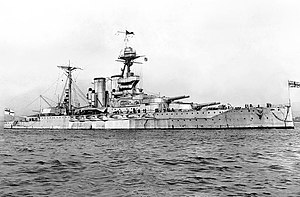
Back Малая (линеен кораб, 1915) Bulgarian HMS Malaya (1915) Czech Malaya (Schiff) German HMS Malaya (01) Spanish اچاماس مالایا Persian HMS Malaya Finnish HMS Malaya French אה"מ מלאיה HE एचएमएस मलया Hindi HMS Malaya Italian
 Malaya about 1919–1921
| |
| History | |
|---|---|
| Name | Malaya |
| Namesake | Federated Malay States |
| Ordered | 1913 |
| Builder | Armstrong Whitworth, South Tyneside |
| Cost | £2,945,709 |
| Laid down | 20 October 1913 |
| Launched | 18 March 1915 |
| Commissioned | 1 February 1916 |
| Decommissioned | 1 December 1944 |
| Stricken | 12 April 1948 |
| Identification | Pennant number: 3A (1914); 84 (Jan 18);[1] 06 (Apr 18); 01 (Nov 19)[2] |
| Motto | Malem Fero Malis ("I bring evil to the evil") |
| Fate | Sold for scrap, 20 February 1948 |
| General characteristics (as built) | |
| Class and type | Queen Elizabeth-class battleship |
| Displacement | |
| Length | 639 ft 9 in (195 m) |
| Beam | 90 ft 7 in (27.6 m) |
| Draught | 33 ft (10.1 m) |
| Installed power |
|
| Propulsion | 4 shafts; 2 steam turbine sets |
| Speed | 24 knots (44 km/h; 28 mph) |
| Range | 5,000 nmi (9,300 km; 5,800 mi) at 12 knots (22 km/h; 14 mph) |
| Complement | 1,217 (1919) |
| Armament |
|
| Armour |
|
HMS Malaya was one of five Queen Elizabeth-class super-dreadnought battleships built for the Royal Navy during the 1910s. Shortly after commissioning in early 1916, she participated in the Battle of Jutland of the First World War as part of the Grand Fleet.
Malaya spent the interwar period between the Mediterranean Fleet, Atlantic Fleet, and Home Fleet. She transported Ottoman Sultan Mehmed VI into exile and served during the 1936-1939 Arab revolt in Palestine. Apart from this, her interwar career was uneventful.
With the outbreak of the Second World War, Malaya served with the Mediterranean Fleet, serving as a convoy escort and fighting in the Battle of Calabria and Operation Grog. In March 1941, she was transferred to the North Atlantic to perform convoy escort duties, during which she prevented the Scharnhorst and Gneisenau from attacking a convoy. Torpedoed in that month by the German submarine U-106, Malaya received repairs in New York. Malaya was withdrawn from serving at the end of 1944 and used as an accommodation ship for the training establishment HMS Vernon. She was ultimately broken up and sold for scrap in 1948.